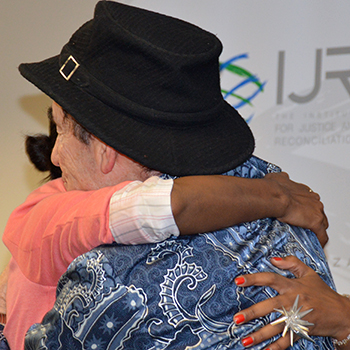Judge Albie Sachs and Candice Mama discuss traumas of the past and forgiveness in the present

Judge Albie Sachs embraces Candice Mama for her courage in confronting Eugene de Kock, who killed her father. |
Two generations. Two stories of triumph. Two South Africans who have displayed immense courage.
Public Dialogue on Trauma, Memory, and Representations of the Past
Judge Albie Sachs and Candice Mama exchanged their experiences of past trauma and subsequent transformation in a public conversation. The event was co-hosted by Prof Pumla Gobodo-Madikizela and The Institute for Justice and Reconciliation (IJR) in Cape Town on Thursday 30 July 2015.
The event was the first instalment in a series entitled Public Dialogue on Trauma, Memory, and Representations of the Past. The theme of the discussion was ‘Intergenerational Dialogue on Trauma and Healing’.
"The aim of these public dialogue events we are co-hosting with IJR is to place the issues of trauma and memory, and the strategies that individuals and communities use to heal, in the public sphere," Prof Gobodo-Madikizela, Senior Research Professor in Trauma, Forgiveness, and Reconciliation Studies at the University of the Free State (UFS) said.
Judge Albie Sachs and Candice Mama in conversation
Former Constitutional Court Judge, Albie Sachs, talked about his participation in South Africa’s liberation struggle, the loss of his right arm in an assassination attempt, and meeting the man responsible – Henri van der Westhuizen. Despite years of exile and extended periods of solitary confinement, Judge Sachs maintains that “we need to acknowledge our history, not be trapped by it.” Judge Sachs also remarked, though, that “we’re seeing too much lamentation, not enough activation.” In a heartrending gesture, Judge Sachs embraced Candice Mama in a hug for her courage in confronting Eugene de Kock, who killed her father.
How poignant then, when Mama said, “I wanted to embrace the brokenness within him,” when she spoke about her meeting with De Kock. By the time I met with Eugene, I could meet him as a human being, not as a villain.” Mama believes that forgiving someone translates into an investment in the person you are forgiving and in your own sanity. She also emphasised the importance of dialogue to move our country forward: “When we share our stories with each other authentically, walls break down.”
This is a stance that Prof Gobodo-Madikizela supports strongly: “When we listen to one another, something unexpected emerges; we encounter the human in each other,” she said. “When we listen with open hearts to each other, we see and experience each other’s humanity.”
Building a bridge between research and society
Referring to the research aspect of the event, Prof Gobodo-Madikizela said that, "in establishing the series of public dialogue events, our vision is to create a bridge between scholarly research and the community at large, on the one hand, and a visual conscience of society, on the other." The UFS is collaborating with the IJR on this research project, which is funded by the Andrew W. Mellon Foundation. The endeavour is led by Prof Gobodo-Madikizela, who also serves as Board Member of the IJR.